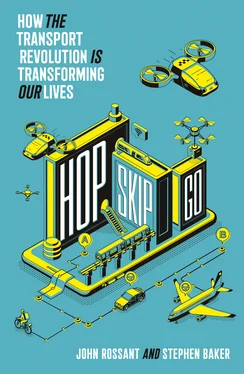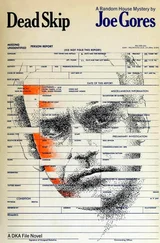By the time the 2028 Olympics roll around, in Garcetti’s vision, the third LA should be on full display, the city’s mobility largely transformed. County-controlled LA Metro plans to have twenty-eight major transit projects completed in time for the ’28 games. They include a doubling of the Metro line, the introduction of electric buses, the availability of subsidized electric ride-share services for the poor and disabled, and the expansion of bike lanes and pedestrian greenways.
The city and county are wooing mobility players big and small, whether they’re running fleets of autonomous jitneys, operating air taxis, or building electric buses. “If you think about the finance capitals of the world,” Garcetti says, “New York and London come to mind. Car cities, Detroit and Munich, Tokyo. But what city is the leader in transportation technology? That’s what I want LA to be.” He points to the city’s leadership in aerospace, the five-hundred-odd tech start-ups along the western strip (so-called Silicon Beach), the two Hyperloop companies, and an openness to experimentation. “I want everyone to come here and try stuff,” he says. “I want LA to be the kitchen where this is all cooked.”
At the same time, he sees LA’s paved roadway, the asphalt tapestry smothering much of the region, as an asset. The roads can be repurposed, he says, parts of them transformed into bike paths and walkways. “Look at the High Line,” he says, referring to a converted stretch of elevated railway in New York City that is now a world-famous park.
Of course, many of the roads will remain focused on their current job: the movement of automobiles. Even as other options emerge, the automobile isn’t deserting Los Angeles any time soon. The region has 6.4 million cars and trucks, and the average vehicle stays in operation for eleven years, many for much longer. So on the eve of the 2028 Olympics, millions of cars would be still circulating in LA even if Angelenos, en masse, stopped buying them today. And that’s not happening.
The idea is not to get rid of the car, but to end the car monoculture. It’s a matter of giving people choices. As this happens, the city will become multimodal and greener. That part of the LA vision sounds like Helsinki, Shanghai, and hundreds of other cities around the world.
In LA, though, one problem stands out: while the city and county are spending billions on new Metro lines and expanded bus service, it’s not yet catching on. Only 7 percent of the population rides public transit. Worse, these numbers have been shrinking . Growing numbers of working poor in the area, data show, are ditching the buses and trains, and instead buying used cars.
This is the downside of economic success. Since the rise of the automobile, public transit in LA, as in much of the car-centric world, has largely served the underclass, including many who cannot afford their own personal vehicle. But now, just as the city leaders try to transition away from the car economy, growing numbers of Angelenos are “graduating” into it. They add to congestion. So do the thousands of Uber and Lyft drivers plying the streets and byways in search of passengers. After decades of progress against smog, LA’s air grew dirtier in 2016 and 2017, registering some of the nation’s highest ozone counts.
Garcetti boils the problem down to one of geometry. You have millions of people trying to get from point A to point B, he says, “and they’re all occupying the same plane.” That plane is defined by the surface of the earth and the roads plastered on top of it.
To visualize the limits of the status quo, think of all the people working in the city hall building. Since they’re organized in layers—thirty-two floors—they’re not too crowded. But most of those people came to work—at rush hour, no less—smushed onto a single plane, along the same ribbons of highway. Only later do they ease this crush by stacking vertically. One solution to the congestion, Garcetti suggests, is to add new planes for mobility, above the earth and beneath it.
FOR SELETA REYNOLDS, urban aerial mobility is not a current pressing concern. Nor are the tunnels Elon Musk’s Boring Company has begun to dig (which we’ll visit in chapter 6
). Reynolds heads the LA Department of Transportation, and her focus is on moving millions of people, most of them by traditional means. She thinks much more about providing decent transportation to have-nots, and doesn’t worry much about the people crawling in Lamborghinis or Porsches up and down the 101.
Reynolds, a Mississippian with a history degree from Brown, came to LA from San Francisco, where she’d been an activist manager in the Municipal Transportation Agency. Her division was Livable Streets, and she oversaw the launch of Bay Area Bikeshare. In 2014, Mayor Garcetti brought her to Los Angeles as the top transportation official. She now sees the city at a crucial transition, much like the one a century ago, from streetcars to automobiles. Back then, for-profit corporations with bottomless reservoirs of dollars for promotion and greasing of the political levers sold the public on an enticing technology. And once the public was behind the wheel, it was hooked. By that point, the government was reduced to satisfying motorists’ demands: building highways, making sure people had places to park—in short, surrendering to the car.
All these years later, as Reynolds sees it, LA has a second chance. Tech entrepreneurs are promising a transformation—mobility that’s cheap, green, and fun. But from Reynolds’s perspective, if the government doesn’t step in and assert a measure of control over this new ecosystem of mobility, the technologists will dictate the shape and nature of the city for the coming century. In that case, it will be made to fit their needs, and their bottom lines, and not those of the eighteen million people living in greater Los Angeles. “We could repeat the mistake we made a century ago,” she says. “We adjusted the city to the technology, instead of the other way around.”
Reynolds focuses most on social equity. Entire neighborhoods of LA are transit deserts. She cites the example of Boyle Heights, a historic Mexican American enclave near downtown that is fenced in by freeways. “If you live there without a car,” she says, “you’re trapped.” Those who cannot move across the region efficiently and at an affordable price lose out on opportunities. They struggle to get to trade schools or to job interviews. Entire job markets lie out of reach. This trend worsens with time. The poor migrate to neighborhoods where the rent is cheap, which often are affordable, in great part, because the transportation is so terrible. In these mobility deserts, the poor get poorer, and many fall behind on their rent. This in turn feeds the epidemic of homelessness in LA.
The obvious answer is to wean Angelenos from their addiction to cars. LA Metro is spearheading this strategy by dramatically extending its network. Plans call for new lines stretching to the airport, and others linking downtown to Hollywood and the UCLA campus in Westwood. By the time the Olympic torch is lit in the LA Memorial Coliseum, according to the plan, LA County may boast the second-largest urban train system in the United States, behind only New York’s.
To some evangelists of the mobility revolution, this seems a bit retrograde. Who will take the Metro if Elon Musk’s underground network springs into action, zipping around Angelenos like packets of data? And what about the fleets of autonomous pods, the next generation of dockless electric bikes, the air taxis?
Читать дальше












